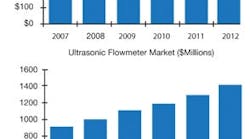According to new studies by ARC Advisory Group, the human-machine interface (HMI) and ultrasonic flowmeter markets are on target for strong growth over the next five years. The HMI software and services market, which totaled over $926 million in 2007, will reach over $1,430 billion in 2012, outperforming the industrial automation market overall and growing at a compounded annual growth rate (CAGR) of over 9.1% over the next five years.
ARC predicts that, propelled by strong growth in the oil and gas industry, the worldwide market for ultrasonic flowmeters will grow at a compounded annual growth rate (CAGR) of 9.9% over the next five years. The market was $367 million in 2007, with ARC-predicted growth to over $589 million in 2012 HMI software suppliers had their best regional development in Asia. However, North America and EMEA also experienced strong growth.
Services and supervisory software led the market growth. “HMI software suppliers are continuing to add services at an accelerated rate, driven by the end users’ and OEMs’ need for technical support, because manufacturers no longer have the personnel internally to provide the services,” according to ARC Research Director Craig Resnick, the principal author of ARC’s “Human Machine Interface Software Worldwide Outlook.”
He went on to say, “Supervisory HMI software, which is used to support HMI software functionality such as configuration, runtime, connectivity, control and alarm management, had the fastest growth of any HMI software type. Growth in this segment indicates how HMI software suppliers are expanding their application space, and it represents the direction that the HMI software market is heading over the next five years.”
Growth Tied to PACs
The common denominator for growth was the use of HMI software solutions tied to the increased use of programmable automation controllers (PACs) in the process and hybrid industries, led by oil and gas, water and wastewater, mining and metals, and electric power. The food and beverage industry maintains its leading position as the largest HMI software market. Windows XP was the fastest growing operating system in terms of revenue. However, Windows CE was the fastest growing operating system in terms of units.
PLC-based PACs and DCS-based PACs are being deployed at an increasing rate in the fast- growing process industries, and each of these PACs requires HMI software to best leverage their capabilities. Automation equipment, including PLC-based PACs equipped with HMI software, play an important role in sustainability initiatives as they help satisfy many “green” demands, including the visualization and control of AC drives, which saves energy. HMI software is used to present digital dashboards to show key performance indicators (KPIs), such as dynamic operational equipment effectiveness (OEE) for the entire enterprise, and to generate reports of actual performance versus targets. Overall operational performance is affected by maximizing the visualization of the HMI software through leveraging technology, such as 64-bit computing and operating systems designed for this hardware, such as Microsoft Vista or Server 2008.
Asia, Latin America, Windows CE to Rule
ARC predicts that the Asia and Latin America HMI software markets will be the fastest growing areas. North America and EMEA will be growing at a considerably slower rate. ARC believes that a significant amount of HMI software adoption has already taken place in these mature markets, especially in the North American and Western Europe automotive industries. Window Vista and Windows CE will be the fastest growing operating systems in terms of units. This growth will be due to Windows CE continuing to replace proprietary software embedded in devices and Windows Vista overtaking Windows XP by the end of the forecast period.
Ultrasonic Flowmeter Market Goes Boom Too
In a separate study, “Ultrasonic Flowmeter Worldwide Outlook,” ARC analyst Allen Avery says that ultrasonic flowmeters, once limited to use in niche applications, have become the fastest growing flow technology, particularly in the hydrocarbon industries. While such technology has been available for decades, it has only in recent years begun to see more widespread adoption.
“Ultrasonic meters offer a compelling value proposition to users and stand poised for widespread adoption in the process industries. In spite of its smaller market size relative to other flow technologies, sustained growth of the hydrocarbon industries and a large installed base of obsolete and maintenance-heavy mechanical metering technologies ripe for replacement will drive near double-digit growth in the coming years,” says Avery.
Almost all of the growth of the process ultrasonic market in recent years has been due to increased shipments to the oil and gas industry, which nearly doubled over previous levels. It appears that the custody-transfer market for natural gas has taken shape, thanks to adoption of the AGA9 custody-transfer standard and the use of ultrasonic meters for liquid custody transfer is increasing. The oil and gas industry has set aside its conservative stance on field device technology and has begun to embrace ultrasonic metering, particularly in new projects that allow the design of an infrastructure appropriate to achieve the best meter performance.
The report goes on to say that fieldbus-enabled smart meters will see strong growth, as flowmeters are installed as part of overall control systems. Communication via fieldbus networks allows users to remotely configure, monitor and control their ultrasonic flowmeters. Meters that use digital communications protocols can also provide users with a wealth of diagnostic information about the health of not only the meter, but also the process. With sophisticated electronics embedded in ultrasonic flowmeters and visualization software, users can monitor flow profiles and the effects of flow conditioning and detect potential line blockages. Armed with this data, users can optimize their meter calibration and maintenance practices.
The largest growth will occur in Asia and EMEA regions. The report predicts that China and India will make robust investments in basic infrastructure and new manufacturing plants. As energy-poor China seeks fuel for its rapid economic growth, it will ramp up its oil and gas infrastructure. The Middle East will continue to be fertile ground for ultrasonic meter suppliers, due to its role in oil and gas production. Growth in North America will be relatively modest, but still healthy, also thanks to investment in oil and gas infrastructure.



